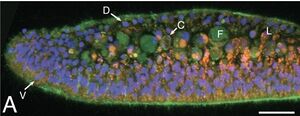Trichoplax
Classification
Domain - Eukarya; Phylum - Placozoa; Family - Trichoplacidae
Species
Genus species: Trichoplax adhaerens
|
NCBI: Taxonomy [1] |
Description and Significance
Trichoplax are the smallest multicellular animal known in science (1). Their diameter is only 1-2mm and they appear as flat, disc-shaped, and have no body symmetry. They are found in tropical and sub-tropical environments (1). Trichoplax Adhaerens, the only concretely defined species within the genus, has the smallest DNA sequence discovered within an animal. Trichoplax adhaerens is viewed as a potential biological model organism as it moves via locomotion and coordinates without full-fledged muscle and nerve tissue. Scientists often think that Trichoplax allows us to imagine how the earliest animals were organized and compartmentalized before complex structures like mouths and nerves. Thus, Trichoplax can serve to be an indicator of important evolutionary processes regarding eukaryotes, allowing scientists to further understand the development of animals.
Genome Structure
Trichoplax's genome is the smallest genome of any animal measured. it consists of six haploid chromosomes. Morphology of the chromosome is unclear. Inside the chromosomes, there are 11,584 genes which are encoded by ~98,000,0000 base pairs (4). A fun fact of the genus Trichoplax is that it shares 80% of its genes with cnidarians and bilaterians, but also 80% of its introns are shared with human's introns (5). Trichoplax having a fairly simple genome and body makes it vital to understand its genome increasingly for it is the smallest multicellular animal known to man. Being the smallest animal leaves many scientists to think it could be the closest common ancestor to all higher animals (2), leaving further research of the genome to be of great value to science.
Cell Structure, Metabolism and Life Cycle
Trichoplax only has 6 cell types. 4 of the 6 are incorporated into the epithelium that encloses it. The epithelium divides into two parts: the upper and lower epithelium. The upper epithelium is thin and the lower is thicker. As cells transition closer to the lower epithelium, cells become progressively more dense. This creates a pseudostratified arrangement. Between the upper and lower epithelium are fiber cells. These fiber cells contact each other by branching and also allow communication between all other cells. Typical gland cells are also present. They are present around the circumference in a ring-like manner as well as sparsely in the organism. They contain neuropeptides which express neurosecretory proteins. There are also crystal cells, containing birefringent crystals, are distributed at near the edge of the animal (3).
There are two main cells in epithelium that aid in the feeding process. The prevalent cell type within the epithelium are columnar cells. They contain a single cilium and multiple microvilli. The single cilium is what allows the cell glide via locomotion. Gliding occurs until algae becomes present, where the Trichoplax halts to feed. This is where the other cell type, non-cilliated lipophil, comes into play. Non-ciliated lipohill cells are composed of large granules and has an even bigger granule proximal on the surface of the upper epithelium. This is where the the algae is ingested through the ventral (upper epithelium) granule. Neurosecretery cells may also have a hand in directing the cell while eating due to the neuropeptides produced. This is similar to animals that are far more complex (3).
Trichoplax reproduce asexually and usally via fission. Fission occurs when two parts of the animal move away until the connection is ruptured (2). This cleaves the organism and allows it to divide and then grow accordingly.
Ecology and Pathogenesis
Trichoplax live in aquatic environments that are rich in seawater. It has rarely been observed in the wild, leaving many questions regarding its benefit to the environment. Besides what is being observed in culture, not much can be said about the symbiotic relationship with the natural habitat. Additionally, there is nothing to be said regarding pathogenic factors.
References
5.) [News Staff (2014) Trichoplax adhaerens genome shows simplest animal has complex metabolic capabilities, Science 2.0. Available at: https://www.science20.com/news_releases/trichoplax_adhaerens_genome_shows_simplest_animal_has_complex_metabolic_capabilities]
Author
Page authored by Mark Peck II, student of Dr. Bradley Tolar at UNC Wilmington.

